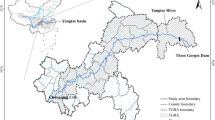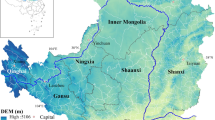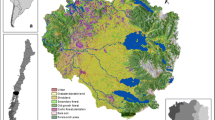Abstract
There is growing interest in using ecosystem services to aid development of management strategies that target sustainability and enhance ecosystem support to humans. Challenges remain in the search for methods and indicators that can quantify ecosystem services using metrics that are meaningful in light of their high priorities. We developed a framework to link ecosystems to human wellbeing based on a stepwise approach. We evaluated prospective models in terms of their capacity to quantify national ecosystem services of forests. The most applicable models were subsequently used to quantify ecosystem services. The Korea Forest Research Institute model satisfied all criteria in its first practical use. A total of 12 key ecosystem services were identified. For our case study, we quantified four ecosystem functions, viz. water storage capacity in forest soil for water storage service, reduced suspended sediment for water purification service, reduced soil erosion for landslide prevention service, and reduced sediment yield for sediment regulation service. Water storage capacity in forest soil was estimated at 2142 t/ha, and reduced suspended sediment was estimated at 608 kg/ha. Reduced soil erosion was estimated at 77 m3/ha, and reduced sediment yield was estimated at 285 m3/ha. These results were similar to those reported by previous studies. Mapped results revealed hotspots of ecosystem services around protected areas that were particularly rich in biodiversity. In addition, the proposed framework illustrated that quantification of ecosystem services could be supported by the spatial flow of ecosystem services. However, our approach did not address challenges faced when quantifying connections between ecosystem indicators and actual benefits of services described.



Similar content being viewed by others
References
Bagstad KJ, Villa F, Johnson G, Voigt B (2011) ARIES—artificial intelligence for ecosystem services: a guide to models and data, version 1.0. ARIES report series, 1.0. The Aries Consortium. http://unstats.un.org/unsd/envaccounting/seeaRev/meeting2013/EG13-BG-7.pdf. Accessed 11 Mar 2016
Bagstad KJ, Semmens DJ, Waage S, Winthrop R (2013) A comparative assessment of decision-support tools for ecosystem services quantification and valuation. Ecosyst Serv 5:27–39
Bagstad KJ, Villa F, Batker D, Harrison-Cox J, Voigt B, Johnson GW (2014) From theoretical to actual ecosystem services: mapping beneficiaries and spatial flows in ecosystem service assessments. Ecol Soc 19(2):64
Bateman IJ, Mace GM, Fezzi C, Atkinson G, Turner K (2011) Economic analysis for ecosystem service assessments. Environ Resource Econ 48(2):177–218
Boumans R, Costanza R (2007) The multiscale integrated Earth Systems model (MIMES): the dynamics, modeling and valuation of ecosystem services. Issues Glob Water Syst Res 2:10–11
Boumans R, Costanza R, Farley J, Wilson M, Portela R, Rotmans J, Villa F, Grasso M (2002) Modeling the dynamics of the integrated earth system and the value of global ecosystem services using the GUMBO model. Ecol Econ 41(3):529–560
Bouwman AF, Kram T, Goldewijk KK (2006) Integrated modelling of global environmental change, an overview of IMAGE 2.4. Netherlands Environmental Assessment Agency. Netherlands Environmental Assessment Agency (MNP), Bilthoven. http://www.pbl.nl/sites/default/files/cms/publicaties/500110002.pdf. Accessed 11 Mar 2016
Boyd J, Banzhaf S (2007) What are ecosystem services? The need for standardized environmental accounting units. Ecol Econ 63(2):616–626
Burkhard B, Kroll F, Müller F, Windhorst W (2009) Landscapes’ capacities to provide ecosystem services—a concept for land-cover based assessments. Landsc Online 15:1–22
Burkhard B, Kroll F, Nedkov S, Müller F (2012) Mapping ecosystem service supply, demand and budgets. Ecol Ind 21:17–29
Chung Y (1998) The methods for increasing water resources in forest. Environ Life 16:120–133 (in Korean)
CICES (Common International Classification of Ecosystem Services) (2013) CICES V4.3. European Environment Agency. www.cices.eu. Accessed 11 Mar 2016
Costanza R, d’Arge R, Groot Rd, Farber S, Grasso M, Hannon B, Limburg K, Naeem S, O’Neill RV, Paruelo J (1997) The value of the world’s ecosystem services and natural capital. Nature 387:253–260
Cowling RM, Egoh B, Knight AT, O’Farrell PJ, Reyers B, Rouget M, Roux DJ, Welz A, Wilhelm-Rechman A (2008) An operational model for mainstreaming ecosystem services for implementation. Proc Natl Acad Sci 105(28):9483–9488
Daily GC, Matson PA (2008) Ecosystem services: from theory to implementation. Proc Natl Acad Sci 105(28):9455–9456
de Groot RS, Alkemade R, Braat L, Hein L, Willemen L (2010) Challenges in integrating the concept of ecosystem services and values in landscape planning, management and decision making. Ecol Complex 7(3):260–272
Dominati E, Patterson M, Mackay A (2010) A framework for classifying and quantifying the natural capital and ecosystem services of soils. Ecol Econ 69(9):1858–1868
Egoh B, Reyers B, Rouget M, Richardson DM, Le Maitre DC, van Jaarsveld AS (2008) Mapping ecosystem services for planning and management. Agric Ecosyst Environ 127(1):135–140
European Union (2014) Mapping and assessment of ecosystems and their services: indicators for ecosystem assessments under action 5 of the EU biodiversity strategy to 2020. Publications office of the European Union, Luxembourg. http://ec.europa.eu/environment/nature/knowledge/ecosystem_assessment/pdf/2ndMAESWorkingPaper.pdf. Accessed 11 Mar 2016
Frélichová J, Vačkář D, Pártl A, Loučková B, Harmáčková ZV, Lorencová E (2014) Integrated assessment of ecosystem services in the Czech Republic. Ecosyst Serv 8:110–117
GFERI (Gyeongsangnamdo Forest Environmental Research Institute) (2014) New forest technology. Gyeongsangnamdo Forest Environmental Research Institute. http://tree.gndo.kr/05research/020703.jsp. Accessed 13 May 14 (in Korean)
Haines-Young R, Potschin M (2010) The links between biodiversity, ecosystem services and human well-being. In: Raffaelli DG, Frid CLJ (eds) Ecosystem ecology. Cambridge University Press, Cambridge, pp 110–139
Haines-Young R, Potschin M, Kienast F (2012) Indicators of ecosystem service potential at European scales: mapping marginal changes and trade-offs. Ecol Ind 21:39–53
Heo HY, Hockings M, Shin WW, Chung HJ, Dudley N, Shadie P, Vaisanen R, Vincent G, Kim H, Park SY, Yang SW (2010) Management effectiveness evaluation of Korea’s protected area system. J Natl Park Res 1(3):169–179
Keppo I, O’Neill BC, Riahi K (2007) Probabilistic temperature change projections and energy system implications of greenhouse gas emission scenarios. Technol Forecast Soc Chang 74(7):936–961
KFRI (Korea Forest Research Institute) (2011) The 5th national forestry inventory report. Korea Forest Research Institute Press, pp 30–36 (in Korean)
KFS (Korea Forest Service) (2007) The effect of forest tending works for improving the green infrastructure function. Korea Forest Service Press, Daejeon, pp 11–22 (in Korean)
KFS (Korea Forest Service) (2010) Forest tending works manual. Korea Forest Service Press, Daejeon, pp 1–10 (in Korean)
Kim JH, Kim KD, Kim RH, Park CR, Youn HJ, Lee SW, Choi HT, Kim JJ (2010) A study on the estimation and the evaluation methods of public function of forest. Korea Forest Research Institute. http://book.nifos.go.kr/KFRICAB/IMG/006/001/155077.pdf. Accessed 11 Mar 2016 (in Korean)
Kim JH, Kim RH, Youn HJ, Lee SW, Choi HT, Kim JJ, Park CR, Kim KD (2012) Valuation of nonmarket forest resources. Korean Inst For Recreat 16(4):9–18 (in Korean)
Koschke L, Fuerst C, Frank S, Makeschin F (2012) A multi-criteria approach for an integrated land-cover-based assessment of ecosystem services provision to support landscape planning. Ecol Ind 21:54–66
Kucharik CJ, Foley JA, Delire C, Fisher VA, Coe MT, Lenters JD, Young-Molling C, Ramankutty N, Norman JM, Gower ST (2000) Testing the performance of a dynamic global ecosystem model: water balance, carbon balance, and vegetation structure. Global Biogeochem Cycles 14(3):795–825
Layke C (2009) Measuring nature’s benefits: a preliminary roadmap for improving ecosystem service indicators. World Resources Institute, Washington. http://pdf.wri.org/measuring_natures_benefits.pdf. Accessed 11 Mar 2016
Lee K (1995) A system for evaluation and allocation of forest functions. J For Sci 41:124–137 (in Korean)
Lee J, Kim J, Seo O (1989) Study on forest classification and evaluation method. Korea Forest Service Press, Daejeon, pp 21–54 (in Korean)
MA (Millennium Ecosystem Assessment) (2005) Ecosystems and human well-being. Island Press Washington, DC. http://www.millenniumassessment.org/documents/document.356.aspx.pdf. Accessed 11 Mar 2016
Maes J, Egoh B, Willemen L, Liquete C, Vihervaara P, Schägner JP, Grizzetti B, Drakou EG, Notte AL, Zulian G, Bouraoui F, Luisa Paracchini M, Braat L, Bidoglio G (2012) Mapping ecosystem services for policy support and decision making in the European Union. Ecosyst Serv 1(1):31–39
Matsuoka Y, Kainuma M, Morita T (1995) Scenario analysis of global warming using the Asian Pacific Integrated Model (AIM). Energy Policy 23(4):357–371
MOE (Korea Ministry of Environment) (2014) Republic of Korea’s fifth national report to the convention on biological diversity. Ministry of Environment. https://www.cbd.int/doc/world/kr/kr-nr-05-en.pdf. Accessed 11 Mar 2016
Müller F, de Groot R, Willemen L (2010) Ecosystem services at the landscape scale: the need for integrative approaches. Landsc Online 23:1–11
Mulligan M, Guerry A, Arkema K, Bagstad K, Villa F (2010) Capturing and quantifying the flow of ecosystem services. In: Silvestri S, Kershaw F (eds) Framing the flow: innovative approaches to understand, protect and value ecosystem services across linked habitats. UNEP World Conservation Monitoring Centre, Cambridge, UK. http://www.unep.org/pdf/Framing_the_Flow_lowres_20final.pdf. Accessed 11 Mar 2016
Naidoo R, Balmford A, Costanza R, Fisher B, Green RE, Lehner B, Malcolm T, Ricketts TH (2008) Global mapping of ecosystem services and conservation priorities. Proc Natl Acad Sci 105(28):9495–9500
Nelson E, Mendoza G, Regetz J, Polasky S, Tallis H, Cameron D, Chan KM, Daily GC, Goldstein J, Kareiva PM (2009) Modeling multiple ecosystem services, biodiversity conservation, commodity production, and tradeoffs at landscape scales. Front Ecol Environ 7(1):4–11
Paltsev S, Reilly JM, Jacoby HD, Eckaus RS, McFarland JR, Sarofim MC, Asadoorian MO, Babiker MH (2005) The MIT emissions prediction and policy analysis (EPPA) model: version 4. MIT Joint Program on the Science and Policy of Global Change. http://globalchange.mit.edu/files/document/MITJPSPGC_Rpt125.pdf. Accessed 11 Mar 03 2016
Parton WJ, Stewart JW, Cole CV (1988) Dynamics of C, N, P and S in grassland soils: a model. Biogeochemistry 5(1):109–131
Perrings C, Duraiappah A, Larigauderie A, Mooney H (2011) The biodiversity and ecosystem services science-policy interface. Science 331(6021):1139–1140
Riahi K, Roehrl RA (2000) Greenhouse gas emissions in a dynamics-as-usual scenario of economic and energy development. Technol Forecast Soc Chang 63(2):175–205
Schröter D, Acosta-Michlik L, Arnell A, Araújo M, Badeck F, Bakker M, Bondeau A, Bugmann H, Carter T, Vega-Leinert A (2004) Advanced terrestrial ecosystem analysis and modelling. ATEAM Final report 2004. Potsdam Institute for Climate Impact Research, Potsdam. https://www.pik-potsdam.de/ateam/ateam_final_report_sections_5_to_6.pdf. Accessed 11 Mar 2016
Sharp R, Tallis HT, Ricketts T, Guerry AD, Wood SA, Chaplin-Kramer R, Nelson E, Ennaanay D, Wolny S, Olwero N, Vigerstol K, Pennington D, Mendoza G, Aukema J, Foster J, Forrest J, Cameron D, Arkema K, Lonsdorf E, Kennedy C, Verutes G, Kim CK, Guannel G, Papenfus M, Toft J, Marsik M, Bernhardt J, Griffin R, Glowinski K, Chaumont N, Perelman A, Lacayo M, Mandle L, Hamel P, Vogl AL (2014) InVEST +VERSION+ user’s guide. The Natural Capital Project, Stanford. http://data.naturalcapitalproject.org/nightly-build/invest-users-guide/InVEST_+VERSION+_Documentation.pdf. Accessed 11 Mar 2016
TEEB (The Economics of Ecosystems and Biodiversity) (2010) The economics of ecosystems and biodiversity: mainstreaming the economics of nature: a synthesis of the approach, conclusions and recommendations of TEEB. http://www.teebweb.org/publication/mainstreaming-the-economics-of-nature-a-synthesis-of-the-approach-conclusions-and-recommendations-of-teeb/. Accessed 11 Mar 2016
Villa F, Voinov A, Fitz C, Costanza R (2004) Calibration of large spatial models: a multistage, multiobjective optimization technique, landscape simulation modeling. In: Costanza R, Voinov A (eds) Landscape simulation modeling: a spatially explicit dynamic approach. Springer, New York, pp 77–116
Willemen L, Verburg PH, Hein L, van Mensvoort MEF (2008) Spatial characterization of landscape functions. Landsc Urban Plan 88(1):34–43
Author information
Authors and Affiliations
Corresponding author
Additional information
Project funding: This study was supported by the Korea Ministry of Environment as “Climate Change Correspondence Program (2014001310008)” and “The Eco-Innovation Project (Project Number: 2012-00021-0002)”.
The online version is available at http://www.springerlink.com
Corresponding editor: Zhu Hong
Rights and permissions
About this article
Cite this article
Choi, HA., Lee, WK., Song, C. et al. Selecting and applying quantification models for ecosystem services to forest ecosystems in South Korea. J. For. Res. 27, 1373–1384 (2016). https://doi.org/10.1007/s11676-016-0259-5
Received:
Accepted:
Published:
Issue Date:
DOI: https://doi.org/10.1007/s11676-016-0259-5




